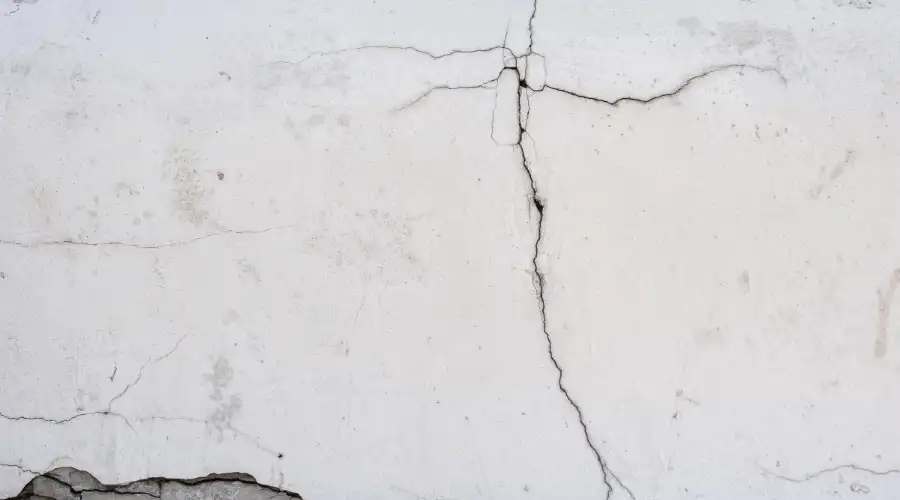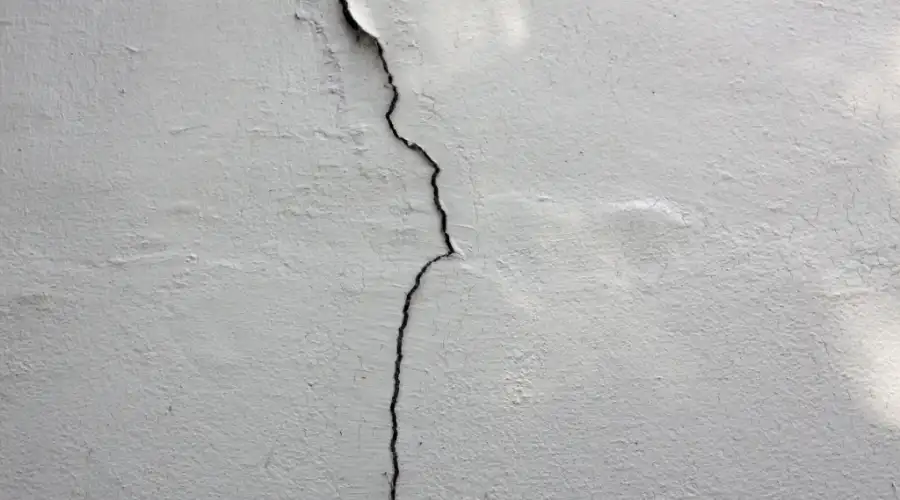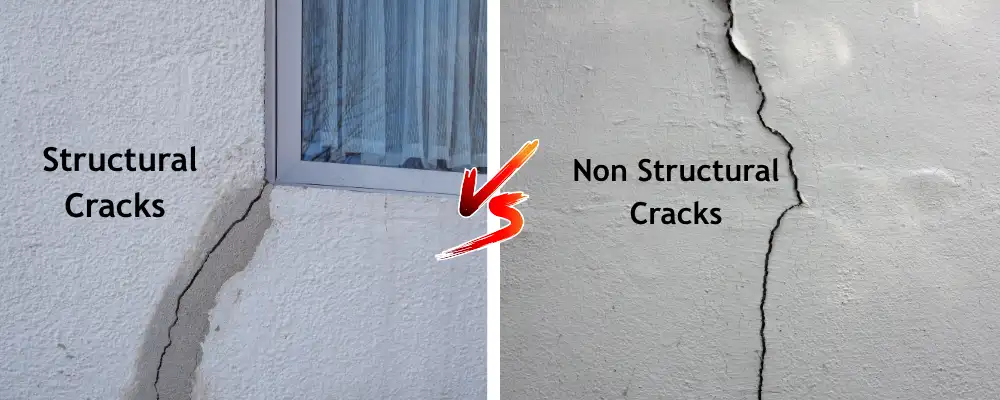Cracks in buildings are not just lines on a wall — they’re signs that tell a deeper story. Whether you’re a contractor, civil engineer, architect, or homeowner, understanding the difference between structural and non-structural cracks is crucial in identifying potential foundation issues and ensuring a safe, long-lasting structure.
Structural cracks often point to deeper problems that can compromise a building’s integrity, whereas non-structural cracks are usually surface-level flaws. However, if neglected, even these minor issues can escalate into major concerns over time.
This blog explores the causes, types, and repair strategies for structural and non-structural cracks, helping you protect your investment, ensure safety, and bring quality to construction.
Overview of Structural Cracks

Structural cracks occur when stresses, due to loads, movement, or environmental factors, exceed what the element can safely accommodate. Cracks may occur for one of the following reasons:
- Movement of the foundation due to soil shrinkage, erosion or improper compaction.
- Excessive loading applied on slabs or walls that are commonly found in industrial situations.
- Differential settlement due to discrepancies between soils causing different movements of the foundation.
- Thermal stress due to components expanding or contracting without any flexibility.
Common signs are non-parallel diagonal lines in the walls, stair-step cracks in masonry, and cracks in excess of 5 mm wide. In most cases of structural cracking, you will also have performance concerns, such as doors binding and sloping floors.
Overview of Non-Structural Cracks

Cosmetic or non-structural cracks result from material behavior, not from lack of structural integrity. Key causes include
- Curing shrinkage of concrete, resulting in hairline cracks in a vertical plane.
- Small temperature changes can cause hairline cracks in plaster and drywall (with no structural significance).
- Uniform or minor settlement in non-load-bearing areas.
Such cracks are usually ≤1/10 inch wide, are static over time, and are limited to nonstructural components like partition walls or finishes.
Key Differences Between Structural and Non-Structural Cracks
| Aspect | Structural Cracks | Non-Structural Cracks |
| What’s the risk? | They are a significant hazard that could seriously undermine the structure and lead to collapses if not addressed promptly. | Though not a safety issue, they can be a point of entry for water and, let’s face it, a building isn’t as attractive with debris-flecked ledgers. |
| How wide are they? | Usually wider than 5 millimeters (the width of a pencil) and they typically grow with time, a sign that something may be amiss. | They are narrow, typically <2.5 mm wide, crescent shaped fractures that tend not to be displaced immediately after occurrence. |
| What do they look like? | These frequently run diagonally in stair-step manner over brick walls or horizontally. They can slice through vital structural parts, such as foundations or beams. | Commonly vertical or horizontal, they run with or at an angle to patterns in plaster or drywall, and are restricted to nonstructural areas. |
| Where do they show up? | These are located at key points in buildings, including foundation, load-bearing walls, columns, beams, and floors. | Occur in non load-bearing elements such as partition walls, plaster, drywall or surface finishes. |
| How deep do they go? | These cracks can be deep, piercing walls or floors and possibly revealing steel reinforcements. | These are superficial, they do not affect structural masses or components and are only on the surface (ie: paint, plaster) of a building. |
| Do they move or grow? | Yes, it often drowns wider or longer, especially when the root cause doesn’t get addressed. | No, they tend to stay fixed once they’ve been formed. |
| How do you spot them? | These kinds of cracks need to be accessed by a team of professional structural engineers. | They’re typically easy to see visually and do not typically require extensive monitoring unless they get worse over time. |
| How are they fixed? | Need professional repairs such as epoxy injection, reinforcements or reconstruction. These are urgent. | While some have been repairable with the application of surface treatments or sealants, typically as part of routine maintenance. |
| How quickly should you act? | Act fast. these cracks need attention right away to prevent bigger problems. | No rush. Technicians can fix these during routine upkeep. |
Causes of Cracking
Structural Crack
- Soil Movement: Occurs due to expansive soils, erosion, or uneven settlement beneath the foundation.
- Overloading: When beams, slabs, or other structural components are subjected to loads beyond their designed capacity.
- Design or Construction Defects: Includes inadequate reinforcement, poor structural detailing, or uneven load distribution.
Non-Structural Crack
- Shrinkage: Caused by plastic or drying shrinkage as water evaporates from fresh concrete or mortar.
- Thermal Movement :Expansion and contraction of building materials due to temperature changes, especially in surface layers.
- Minor Impact or Stress Concentration:Localised damage from construction activities or small external forces.
Repair Methods
Structural Crack Repairs
- Epoxy Injection: Involves injecting a high-strength epoxy resin under pressure into the crack to restore the tensile strength and integrity of the concrete.
- Stitching: Metal rods or wires are drilled and grouted across the crack to hold the sides together and restore load transfer.
- External Pre-Stressing (Straining): Applies external force (typically using tensioned cables or plates) to counteract tensile stresses and stabilize the structure.
Non-Structural Crack Repairs
- Routing and Sealing: Involves enlarging the surface crack slightly (routing) and then filling it with an appropriate flexible sealant to prevent moisture entry and improve appearance.
- Overlays: Application of a thin surface layer, typically polymer-modified cement or micro-topping, used to restore aesthetics, improve waterproofing, and cover minor surface imperfections.
Conclusion
A structural crack may require immediate remediation to prevent potential structural failure, whereas a non-structural crack may only call for routine monitoring and cosmetic repair. Accurate classification—based on crack width, orientation, and rate of progression—ensures that appropriate repair methods and resources are applied. Cracks that are growing, exceed 5 mm in width, or are associated with visible signs of distress in the structure must be professionally assessed. Implementing a preventive inspection strategy helps mitigate risks posed by both structural and non-structural cracks.
FAQs
Yes. If underlying issues such as soil movement, moisture intrusion, or foundation settlement worsen, non-structural cracks can develop into structural problems. Regular monitoring is essential to detect early warning signs.
Not always. Horizontal cracks in load-bearing elements like foundation walls can indicate serious structural stress (e.g., due to lateral soil pressure). However, horizontal cracks in non-load-bearing walls or plaster layers may be superficial and non-structural.
Cracks less than or equal to 1 mm are generally considered non-structural and safe if they are stable and do not grow over time.
No. Structural repairs require specialized techniques like epoxy injection or underpinning, mandating expert intervention.

